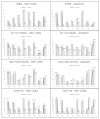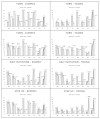Muscle Activation and Distribution during Four Test/Functional Tasks: A Comparison between Dry-Land and Aquatic Environments for Healthy Older and Young Adults
- PMID: 32629839
- PMCID: PMC7370020
- DOI: 10.3390/ijerph17134696
Muscle Activation and Distribution during Four Test/Functional Tasks: A Comparison between Dry-Land and Aquatic Environments for Healthy Older and Young Adults
Abstract
Background: The use of rehabilitation protocols carried out in water has been progressively increasing due to the favorable physical properties of the water. Electromyography allows one to register muscle activity even under water.
Aim: To compare muscle activity between two groups (healthy young adults (HYA) and healthy older adults (HOA)) in two different environments (dry land and aquatic) using surface electromyography during the execution of four different test/functional movements.
Methods: Analytical cross-sectional study. HYA and HOA carried out four functional tasks (Step Up and Down, Sit To Stand test, Gait Initiation and Turns During Gait) in two different environments (dry land and aquatic). Absolute and relative muscle activation was compared between each group and between each environment. In addition, the stability of the measured was calculated through a test-retest (ICC 2:1).
Results: Within the same environment there were significant differences between young and older adults in three of the four functional tasks. In contrast, in the gait initiation, hardly any significant differences were found between the two groups analysed, except for the soleus and the anterior tibial. Measurement stability ranged from good to excellent.
Conclusions: Level of the musculature involvement presents an entirely different distribution when the test/functional task is performed on dry land or in water. There are differences both in the relative activation of the musculature and in the distribution of the partition of the muscles comparing older and young adults within the same environment.
Keywords: electromyography; healthy aging; posture; water.
Conflict of interest statement
The authors declare no conflict of interest.
Figures





